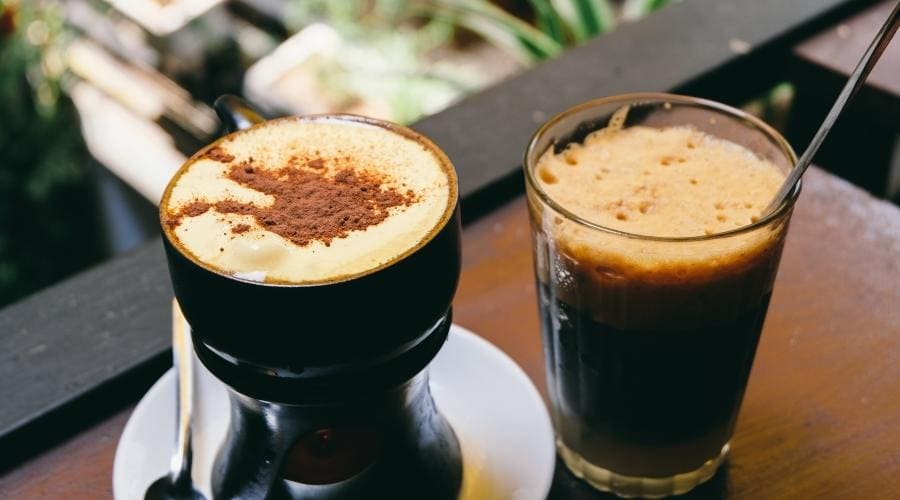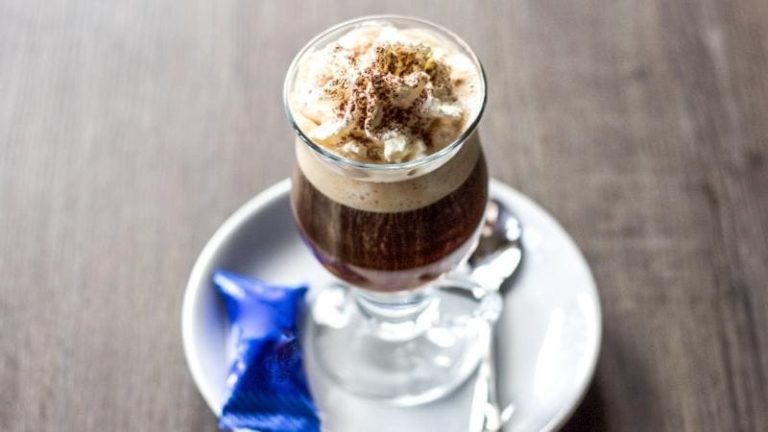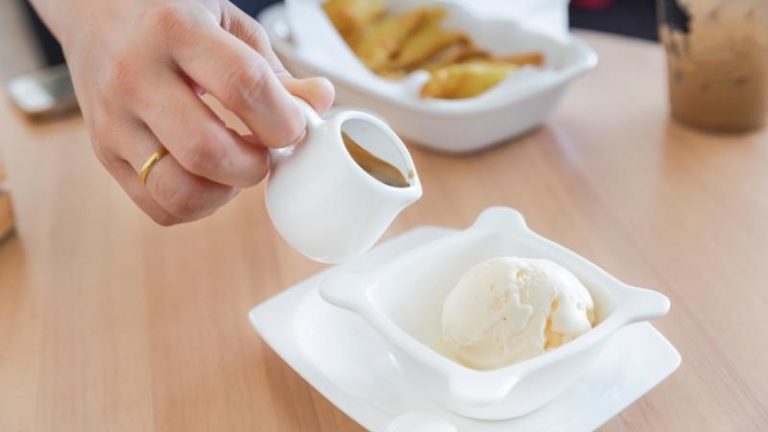When it comes to coffee, the style matters. Every coffee fanatic will tell you that. This is for the obvious reason that distinct coffee types are prepared differently using different ingredients and thus, have different tastes.
Of the many coffee styles around the world, the Vietnamese and Turkish styles are pretty popular. In this article, we will look at dive deep into everything you need to know about the two. Let’s go.
Turkish coffee vs Vietnamese Coffee Major differences
| Vietnamese Coffee | Turkish Coffee |
|---|---|
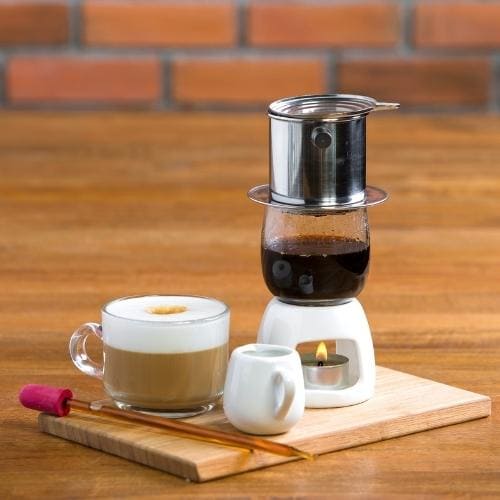 | 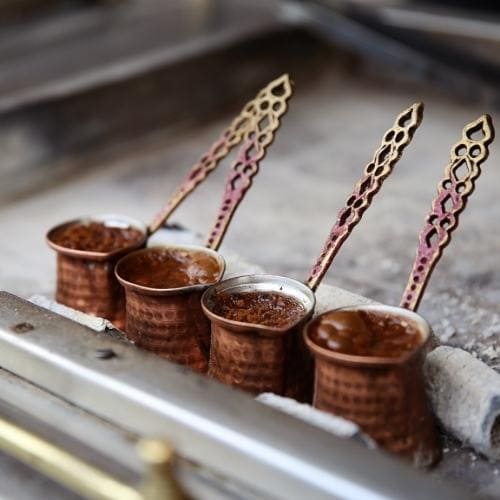 |
| Filtered using a phin | Poured directly from a Turkish coffee pot. |
| Mostly made from Robusta coffee beans. | Mostly made from Arabica coffee beans. |
| Strong due to the high caffeine concentration in Robusta (2.7%). | Less strong due to the low caffeine concentration in Arabica (1.5%). |
| Water is boiled first and then poured into the coffee beans. | The fine coffee beans and the water are boiled together. |
| No foam. | Has foam. |
| No coffee grounds in the drinking glass. | Coffee grounds settle at the bottom of the drinking glass. |
| Uses condensed milk | No condensed milk |
Turkish coffee vs Vietnamese coffee making process
The Turkish coffee-making process is more direct and easy whereas the Vietnamese coffee-making process is relatively complex.
Turkish coffee
Turkish coffee is generally made by boiling extra fine ground coffee. As pointed out earlier, Arabica coffee is mainly used for Turkish coffee as compared to the Vietnamese style that uses Robusta.
You will need the following ingredients:
- Finely ground (Flour-like) coffee beans. Preferably Arabica.
- Water
- Sugar (Optional)
A special Turkish coffee pot called Cezve (Ibrik in other areas) is used in the boiling process. The Cezve is a bowl that is deep and narrow usually made of copper and a wooden handle. You will of course need a teaspoon and a cup.
For every cup of water, you will need to have two teaspoons of fine coffee beans. Mix the fine coffee beans and the water well before you put it to boil. Put the mixture in the Ibrik and add some sugar (Optional). Use medium heat to boil the mixture for around 5 minutes.
After boiling, the coffee will have a thick foam which is then poured into the cup directly. It is commonly believed that Turkish coffee should have at least 1 cm of foam to be considered well brewed.
The coffee in the cup is then served with a glass of water and a Turkish delight. Because the Turkish coffee is not filtered, the grounds will settle at the bottom of the cup.
Vietnamese coffee
Brewing Vietnamese coffee is slow and kind of an experience. This is because the coffee is made by the drip method. This means that the process takes more time to brew because it is drop-by-drop.
To brew the coffee, you will need the following:
- Vietnamese coffee grounds can be found in Asian markets or ordered online. They’re mostly made of Robusta coffee beans.
- Condensed milk.
- Ice cubes
- A phin. This is a coffee press that is used in the brewing process. The phin has a plate, cup, lid, and press. It can also be bought in Asian supermarkets.
- Boiling water
To brew a cup of the coffee, you will need a cup of boiling water, 2 tablespoons of coffee grounds, 2 tablespoons of condensed milk, and several ice cubes.
The brewing process starts by pouring the condensed milk into a glass. You can put one spoon to start with and add to taste as the process continues. Place the plate of the phin on top of the glass and then the cup. You will then have to put the coffee grounds on the filter and put the lid on top of the coffee grounds.
Have the boiling water ready and pour a little onto the filter. This allows the grounds to expand and release carbon dioxide. This process should take around 30 seconds. You will then pour the rest of the boiling water into the filter. Cover the lid and give it time. You should wait until the water stops dripping. You can then remove the filter and stir the coffee with a spoon. This coffee can now be poured into a glass with ice.
Due to the filtering process, Vietnamese coffee does not have form or grounds as in the case of Turkish coffee. It is also not very strong because the Arabica mostly used has a low concentration of caffeine.
History of Vietnamese coffee (Cà phê đá)
In Vietnam, coffee was introduced around the mid-19th century by a French Catholic priest. The tropical climate in the northern region of the country provided good climatic conditions for the coffee to grow. It was adopted into the Vietnamese way of life and became a huge part of life in the country.
During those colonial days, it was very difficult to get fresh milk because dairy farming was also not common at that time in Vietnam. This led to the use of condensed milk as a substitute. Although fresh milk became readily available over time, people were already used to using the condensed milk and they found it hard to shift to fresh milk. It was already a rooted culture in Vietnam. This culture still holds to date.
By the end of the 19th Century, coffee was one of the major crops grown in Vietnam. Unfortunately, coffee growing was heavily affected by the 20 years Vietnam war that ravaged the country from 1955 to 1975. After the war, the government prioritized coffee growing and Vietnam subsequently became the second largest exporter of coffee and the largest exporter of Robusta coffee in the world.
Vietnamese coffee is special since it mainly uses Robusta coffee which has a high caffeine concentration. This makes it very strong (Bitter as described by many).
History of Turkish coffee
Turkish coffee has a lot of rich and a long history which I will try to make short. Coffee was introduced in the ottoman empire around the year 1541. Sultan Suleiman the magnificent got his first taste after it was offered to him by Ozdemir Pasha, the Ottoman ruler of Yemen.
The sultan liked the coffee and gave a royal decree that coffee be adopted for farming in his territory. This is how coffee came into Turkey. Sultan Suleiman developed a very high liking for the coffee that the palace workers started finding new ways of making the coffee to please him. They crushed the coffee beans and boiled them in a special jug. This was also very pleasing to the wife of the sultan Hurrem Sultan.
The first coffee shop was opened in Istanbul by two Arabs from Syria. Coffee was declared by the authorities at the time to be something good for the empire. This is how the coffee culture spread in Turkey. The general public started developing a culture of taking coffee and it was no longer a palace drink. The reigning era of Sultan Murad III saw an increase in the number of coffee shops to around 600. They also spread from the capital to other parts of the country.
Due to the increasing culture of people gathering in Coffee shops to take coffee, Sultan Murad IV saw it as a threat to the state. He argued that people could gather in the coffee shops and incite each other to disobey royal decrees and hold anti-state gatherings. He, therefore, banned coffee shops in the country.
Turkish coffee significantly increased during the reign of Sultan Abdel Aziz and Abdul Hamid. It is considered the golden era of Turkish coffee cafes. This is how coffee spread from Turkey to the rest of the world.
Turkish coffee is mainly from the Arabica type of coffee and is, therefore, less strong compared to Vietnamese coffee because Arabica has a low caffeine concentration.
Top Vietnamese coffee phins
There are many Vietnamese coffee phins in the market today. However, we will only mention a few popular good ones that you can consider purchasing for your homemade Vietnamese coffee
Gladiator Vietnamese Coffee Maker

This one has a size of 3.5 by 3.5 by 3.5 inches. It is very compact and ideal for traveling purposes. It is made of stainless steel which makes it very durable.
Thang Long Coffee Press

Thang Long Coffee Press is made in Vietnam. The good news is that it has a lifetime warranty and it is very ideal when making iced Vietnamese coffee. It has a size of 3.8 by 2.8 by 2.7 inches and is made of stainless steel which makes it very durable.
Import Food Coffee Maker

This is a smaller phin that is also suitable for traveling. It comes with 2.6 by 2.6 by 2.6 inches stainless steel and rubber handles. It also has printed instructions that make it very easy to use.
Heirloom’s Vietnamese Traditional Coffee Phin Filter

This one comes with a size of 3.5 by 3.5 by 3 inches. It is highly trusted because of its durability. It is made of stainless steel and rubber handles and it is very easy to use.
How to get a good Turkish coffee pot
A good Turkish coffee pot will make your coffee brewing process very fast and efficient. The pots are mainly made of brass, stainless steel, or copper. All these materials are good but each has specific advantages.
Copper is a very good conductor of heat and thus very effective when it comes to saving heat and making the process of brewing faster. It is also very easy to clean but can corrode over time.
Brass does not corrode as easily as copper, it’s therefore a bit more durable. It does not also rust.
Stainless steel is easy to maintain and clean. Among the three options, stainless steel has the highest longevity.
Conclusion
If you have not tried both Vietnamese coffee and Turkish coffee, it is worth trying both styles and then making a decision as to which you like most. Both of them are unique in their own way and so this comes down to your personal taste and preference.
The requirements for making both styles are pretty available in the market and pocket friendly. I hope you find your taste.
That said, regardless of how you choose to enjoy your coffee, you might also like to check out these Trendy Coffee Additives you Probably Didn’t Know About.

